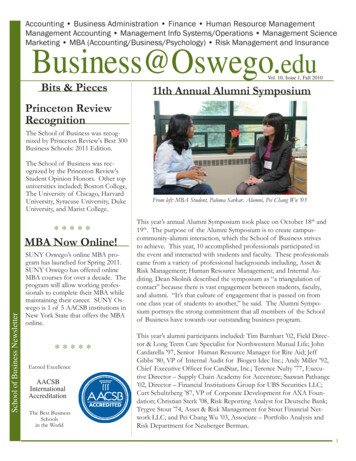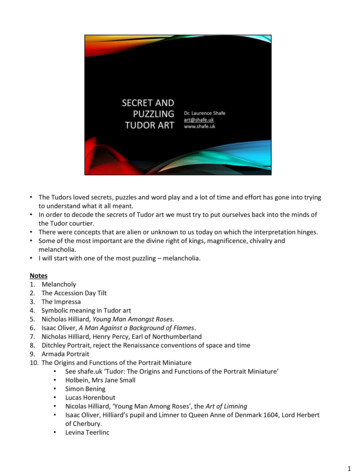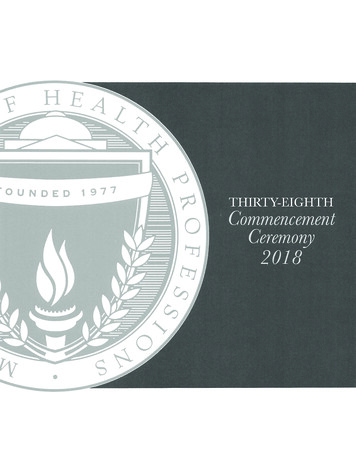
Transcription
38th Annual HilliardSymposiumMay 20, 20218:20am – 3:40pm CT ZOOMWinners will be announced at 5:00 pm.Artwork by Jack Hegarty, Dravid Group.1
John E. Hilliard, 1926-1987John E. Hilliard joined the faculty of Northwestern University in 1962 andtaught here for the next quarter of a century. Born and educated in theUnited Kingdom, he received his Ph.D. from the University of Liverpool.There followed a postdoctoral appointment at the Massachusetts Instituteof Technology and six years at the General Electric Research Laboratory,before he came to Northwestern.Dr. Hilliard was an inspiring teacher for not only his students but also forhis colleagues and the wider metallurgical community. His work includedfour areas of research: the study of the thermodynamic and kineticprocesses in inhomogeneous systems, the quantitative characterization ofstructure, the theoretical and experimental study of spinodaldecomposition, and the synthesis and investigation of compositionallymodulated films. The last two areas represent pioneering work, for whichhis publications are cited with enormous frequency.2
SPEAKER SCHEDULECentral Time Zone8:20 AM Welcome by Professor Derk Joester, Symposium Chair8:30 AM Keynote by Professor Mariana Bertoni9:30 AM Remarks by Professor Derk Joester9:40 AM Kristen Wek – Stupp Group, 4th YearA Hierarchically Structured Microparticle Platform for Regenerative Medicine10:00 AM Chase Brisbois – Olvera Group, 5th YearLocomotion of Magnetoelastic Membranes10:20 AM Travis Schmauss – Barnett Group, 5th YearSurface Modification of Solid Oxide Electrodes for Robust Energy Storage10:40 AM Haiyue Huang – Huang Group, 4th YearOn-mask Chemical Modulation of Respiratory Droplets11:00 AM 10-minute Break
SPEAKER SCHEDULE11:10 AM Raymond Wang – Rondinelli Group, 5th YearLearning the Crystal Structure Genome for Property Classification11:30 AM Luke Prestowitz – Huang Group, 6th YearTowards Nanoarchitectonic Materials11:50 AM Ramya Gurunathan – Snyder Group, 4th YearPredicting the Thermal Resistance of Grain Boundaries and Interfaces12:10 PM James Male – Snyder Group, 4th YearImproving Doping in Lead Chalcogenide Thermoelectrics12:30 PM Diversity, Equity, and Inclusion presentation by Dr. Michael Rawlings, TMS
SPEAKER SCHEDULE1:30 PM Chunyi Huang – Lauhon Group, 5th YearDoping Control in Nanowires for Quantum Computing1:50 PM Sonal Rangnekar – Hersam Group, 5th YearAn Aerosol-Jet-Printed Graphene Biosensing Platform for Rapid Electrochemical Detection of Proteinsand Small Molecules2:10 PM Allessandra Dicorato – Joester Group, 6th YearMulti-Scale Imaging of Nanomaterial-Tissue Interactions2:30 PM Kelly Parker – Dravid Group, 5th YearSoft Microscopy: Advancing High-Throughput Characterization at Low-Voltage2:50 PM Break3:00 PM Donghoon Shin – Mirkin Group, 3rd YearBridging the Gap Between Halide Perovskite Nanocrystals and Thin-Films: Mesoscale HalidePerovskite Arrays3:20 PM Liban Jibril – Dravid/Mirkin Group, 4th YearNanoparticle Synthesis in Hollow Silica Shell Nanoreactors3:40 PM Closing Remarks
KEYNOTE SPEAKERProfessor Mariana Bertoni, ASU8:30 AM CTChasing the sun from academia to industry and back againThe solar PV market continues to accelerate in adoption and over the lastdecade we have seen it move from niche generation to reaching grid parity andbecoming a mainstream electricity generation source. The reality of siliconmodule prices below 0.35/Wdc and updated Nationwide goals of 0.02/kWh by2030 has fundamentally changed solar R&D. As we move towards an “electricpowered world” and everything around us starts demanding electricity in aclean and efficient way, new challenges arise. Similar to many consumerapplications, R&D hurdles centered around aesthetics, customization andfunctionality will be part of our everyday life.In this talk, I will share with you my adventures in solar R&D in academia,industry and the start-up world. We will walk through the maturity of varioussolar technologies, research at the pace of industry and the hurdles for theimplementation and mass adoption of new technology.
Presentation on Diversity, Equity & InclusionImplicit Bias Workshop12:30 – 1:30 PM CT4:00 – 5:00 PM CTDelivered during the Hilliard lunch hour.DR. MICHAEL J. RAWLINGS, TMSSeparate Zoom link.STEFANIE HICKS, NU
Locomotion of Magnetoelastic MembranesNanoscale magnetoelastic membranes are composites of superparamagnetic nanoparticles that can elastically deform inresponse to magnetic fields. This class of active material is particularly suited for robotic applications in nanomedicine becausethey operate at small scales, do not interfere with biochemical systems, and possess no residual magnetization. However,applications in drug delivery or microsurgery necessitate microrobots that swim through their environment. Swimming ischallenging at small scales and requires non-reciprocal motion. While not yet experimentally realized, we use molecular dynamicssimulations to study the possible actuating states of circular magnetoelastic membranes and search for motion compatible withChase A. BrisboisB.S., NanoscaleScience, SUNYAlbany, 2014microswimming. We find precessing magnetic fields, above a critical frequency, can generate circumferentially and radiallypropagating waves, a type of non-reciprocal motion. We then introduce hydrodynamic effects using a lattice Boltzmann fluid.Truncating circular segments from the membranes allows for a circular swimming path and linear swimming can be achievedwhen the external magnetic field is programmed. The principles established here lay the foundation for the control and design offuture magnetoelastic membrane systems.Chase Brisbois received his B.S. in Nanoscale Science from SUNY Albany. He spent two years as a post-baccalaureate research fellow at the National Institutes ofHealth studying the structure of protein-lipid complexes called “nanodiscs”. His research work in the Olvera de la Cruz group at Northwestern focuses on the physicsof magnetic composite materials using computational methods. Last year, he was a recipient of the International Institute of Nanotechnology's Outstanding GraduateResearcher Award. When Chase isn't furiously typing away on the computer, you may find him running along Lake Michigan or tending to the plants his cats have yetto destroy.
Multi-Scale Imaging of Nanomaterial-Tissue InteractionsNanomaterials display extraordinary promise to revolutionize cancer treatment due to their biologically relevant size and tunableproperties. Despite the abundance of therapeutics developed in the laboratory, however, as of 2019 only 28 nanomedicines wereFDA approved. This lack of clinical translation is due, in part, to the array of barriers that may limit delivery of a therapeutic, whichcan make pinpointing a cause of failure challenging. To overcome this bottleneck, improved understanding of thenanomaterial/tissue interface is required, a task which demands visualization of nanomaterials in tissue at multiple length scales,from the micrometer length scales of subcellular compartments to the large scales of tumors themselves. In this work, weestablish a multi-scale imaging platform that can be used to evaluate delivery of nanotherapeutics to cells and solid tumors. WeAllessandra DicoratoB.A., Cornell University,2015demonstrate proof-of-concept by analyzing platinum-stabilized arsenic-loaded ‘nanobins’, as delivered to a patient derivedxenograft model of glioblastoma. Using MRI, light microscopy, TEM, LA-ICP-MS, synchrotron XRF, cryogenic x-raynanotomography, and XANES, we show that nanobins are delivered to the brain and tumor, are internalized within cells, and mayenter cell nuclei. We further show that arsenic glutathione may be a major metabolite in cells. Finally, we illustrate that arsenicand platinum are transported differently in the cell through endosomal recycling, implying that arsenic, the drug’s cytotoxic agent,escapes the endosomal pathway, which can limit therapeutic delivery. Our platform is highly generalizable and may be extendedto other systems, thus offering a systematic approach to expedite translation of nanomaterials to the clinic.Allessandra DiCorato earned her BA in Chemistry and Chemical Biology with minors in Biomedical Engineering and English from Cornell University in 2015. As anundergrad, she worked in the biomineralization research group of Professor Lara Estroff, studying the bio-inspired growth of hybrid materials. She is currently a 6thyear PhD candidate in Professor Derk Joester's group, where she uses multi-scale imaging techniques to study the interactions between nanomaterials and tissuethat arise in two contexts -- in the development of calcitic endoskeletons in sea urchin embryos, and in the delivery of an arsenic-based therapeutic to glioblastomatissue. She is a member of the Chemistry of Life Processes T32 Traineeship, Ryan Fellowship, and AAAS Mass Media Fellowship communities. In her free time,Allessandra enjoys reading, writing, baking birthday cakes for friends, and finding new neighborhoods and parks across the city.
Predicting the Thermal Resistance of Grain Boundaries and InterfacesHeat management is an often a bottleneck for device efficiency, in technologies ranging from power electronics tothermoelectric modules. These same materials and devices tend to contain a high density of grain boundaries and interfaces,which, depending on the application, may need to be either thermally conductive or thermally resistive. As a result, modelswhich can predict the thermal boundary (or Kapitza) resistance (RK) from information about interface chemistry, structure, andtype are highly impactful and can enable theory-guided thermal engineering of materials. However, the current standardtheory for RK only considers the bulk properties of the material surrounding the interface and neglects the defect structure ofthe interface itself. Here, we develop a continuum-level model for RK which explicitly considers scattering due to theRamya GurunathanB.S. Materials Scienceand Engineering, PennState University, 2016M.Phil ScientificComputing, Universityof Cambridge, 2017dislocation strain present at low-energy grain boundaries and interfaces. We apply this model to compare the thermalresistance of Si twist and tilt grain boundaries as well as the Si-Ge heterointerface. In addition to improving the accuracy ofthe predictions, the dislocation strain model reproduces trends observed experimentally and computationally between thermalresistance and grain boundary angle and energy. Finally, we can estimate the percentage contribution of dislocation strainscattering to the overall RK, which may be tunable through annealing and control of microstructure, versus the acousticmismatch scattering, which is typically fixed for a given material. In summary, we devise a simple, scalable model for thermalboundary resistance RK, which retains important physical relationships between RK and interface structure.Ramya is a PhD candidate in Prof. Jeff Snyder’s group at the Northwestern Materials Science and Engineering Department. She received her B.S. in MaterialsEngineering at Penn State University. She then traveled to the University of Cambridge on a Churchill Scholarship and earned an MPhil in Scientific Computing. Inher PhD, Ramya is working to model the interactions between heat-carrying phonons and structural defects. She has received the Cabell, Data Science Initiative,and PPG fellowships while at Northwestern. Outside of research, she currently serves as a graduate representative to the department diversity, equity, inclusion(DEI) committee and stays involved in science outreach through programs like Science Club. Ramya likes to make the most of the Chicago seasons with winter icehockey and summer lake swimming.
Doping control in nanowires for quantum computingThe manipulation of Majorana zero modes (MZMs) in semiconductor nanowire networks has been proposed as a means ofquantum computing. The basic recipe is putting a superconductor in proximity to a semiconductor nanowire with strong spinorbital coupling. The leading material candidates are InAs nanowires. In this work, we grow the branched InAs nanowires at awafer scale with GaAs nanomembranes as templates by molecular beam epitaxy (MBE). However, it is very challenging tocontrol the nanowire morphology and dopant incorporation simultaneously. With the help of atom probe tomography (APT), atime-of-flight technique that is capable of 3D compositional measurements at atomic scale, we have made progress towardsChunyi HuangB. Eng., TsinghuaUniversity, 2016self-assembled nanowires with the target doping profile, namely, remote doping. During the process, we have studied thenature of dopant incorporation and evolution of growth facets. This work lays the groundwork for doping control in scalablenanowire networks, including materials beyond InGaAs.Chunyi is a fifth-year PhD student in Lauhon group. She received her Bachelor of Engineering degree at Tsinghua University (THU). While at THU, she did researchon thermochemical cyclic splitting of CO2 catalyzed by metal oxides in Prof. Duan Weng's group. She also has some experience on soft materials when she workedon self-assembly of block copolymers in Prof. Alexandra-Katz group in MIT. At Northwestern, her research focuses on characterization of III-V heterostructures, morespecifically, understanding the correlation between doping, strain and growth interface evolution. In her spare time, Chunyi enjoys traveling, WERQ, playing the pianoand reading.
On-mask Chemical Modulation of Respiratory DropletsMask wearing has become a new norm in many parts of the world in the COVID-19 pandemic. There has been much interestin enhanced masks that can better protect the wearers. However, a mask or face covering is much more effective inprotecting others because it can block and reroute a large portion of the virus-laden respiratory droplets from symptomatic orasymptomatic infected wearers. Here, we propose an on-mask chemical modulation strategy to enhance this function bymaking the escaped droplets less infectious. As a proof of concept, antipathogen agents (e.g., mineral acid and copper salt)preloaded on nonwoven fabrics are shown to transfer to and are concentrated in escaped droplets to the level capable ofdeactivating pathogens. We hope that this approach leads to additional work, which, if eventually adopted, can help to cutHaiyue HuangB.S., Shanghai JiaoTong University, 2017down the sources of transmission and strengthen the public health response to control and mitigate the outbreak ofinfectious respiratory diseases.Haiyue is a doctoral candidate in the Department of Materials Science and Engineering at Northwestern University, where she works with Prof. Jiaxing Huang onprocessing and assembly of two-dimensional materials. She is also developing healthcare materials and innovations for better and safer living.
Nanoparticle Synthesis in Hollow Silica Shell NanoreactorsNanoparticle synthesis within nanoreactor templates has recently emerged as a highly attractive group of methods tosynthesize complex nanoparticles. A nanoreactor template is simply an isolated volume with maximum feature lengths lessthan 1 µm, which limits mass transfer of particle precursors and nanoparticles across the reactor periphery. Nanoreactorsare attractive because reactor size and chemical contents can be used as modular handles to determine the final particleproduct, without excessive synthetic fine-tuning. This talk describes the strengths and challenges associated with hollow silicashell reactors and proposes a new strategy for addressing these challenges. Specifically, large individual nanoparticles withina template shell are taken as the desired particle product, as incomplete coarsening within a reactor typically results inparticles of random or inconsistent stoichiometry. Herein, we describe a technique to improve the yield of desired particleproducts by studying how polymers can enhance gold nanoparticle coarsening within hollow silica shells.Liban JibrilB.S., ChemicalEngineering, Universityof California, SanDiego, 2017Liban is a fourth-year Ph.D. candidate in Materials Science and Engineering, working with Professors Chad A. Mirkin and Vinayak P. Dravid. Prior to Norhwestern,he earned his B.S. in Chemical Engineering from the University of California, at San Diego. His current research focuses on unconventional approaches to controlnanoparticle synthesis, specifically confined-template approaches, termed nanoreactors. He earned the Northwestern Ryan Fellowship from the International Institutefor Nanotechnology, as well as the National Science Foundation Graduate Research Fellowship. In his free time, he enjoys watching T.V., playing sports, andsuffering through Arsenal games.
Improving doping in lead chalcogenide thermoelectricsDefects are utilized in materials design to optimize properties of next generation devices like thermoelectrics, solid-statebatteries, fuel cells, and photovoltaics. Semiconductors, in particular, must be doped for their many technologicalapplications. However, the subtle effects of thermodynamics on defects and doping efficiency in semiconductors are oftenoverlooked. Thermoelectric semiconductors perform best with degenerate carrier concentrations, meaning new materialsmight be held back by poor doping efficiency. Indeed, inconsistent performance is pervasive in the thermoelectrics literature,which harms the perceived reliability of thermoelectric devices. This study examines phase equilibrium and doping in n-typePbTe to provide a pedagogical framework for consistently synthesizing high-performance thermoelectric semiconductors. Asaturation annealing technique is used to a explore the thermodynamic pathways leading to both the highest dopingJames MaleB. S. MaterialsEngineering,Rensselaer PolytechnicInstitute, 2017efficiencies and performance in PbTe. The best performance is found to be reproducible only when excess Pb is added to thestructure through saturation annealing. Shortcomings in the literature are thus attributed to compensating vacancy defectscaused by a simple deficit of Pb. The concepts applied here linking phase equilibrium to doping efficiency are understandablewith a basic materials science education. Applying such concepts beyond lead chalcogenide thermoelectrics can ensurereproducible, optimal, and reliable performance in both new and classic materials systems.James is a 4th year PhD student in the Department of Materials Science and Engineering, advised by Professor G. Jeffrey Snyder. He obtained his B.S. in materialsengineering from Rensselaer Polytechnic Institute in 2017. James works closely with NASA’s Jet Propulsion Laboratory as part of the NSTGRO fellowship to makethermoelectric materials more reliable using basic thermodynamics. Despite living in the flat Midwest, James is an avid snowboarder, camper, and hiker. In nonpandemic times, James loves traveling to conferences and going to concerts without worrying about strangers breathing on him.
Soft Microscopy: Advancing High-Throughput Characterization at Low-VoltageThe structure-function relationship is essential to our understanding of materials systems; it spans length scales from atomicstructure and chemical makeup to nano- and microscale properties and architecture to bulk or device-level function. Electronmicroscopy (EM) provides essential capabilities for the characterization of soft and biological structures, but the challengesassociated with soft imaging are two-fold: Soft materials have low inherent contrast, and the electron dose required to achievereasonable contrast causes significant damage. With rapid development of new materials and constructs, particularly insynthetic biology, imaging can be the bottleneck for complete characterization. While precedent often encourages cryo-EMwhen imaging biological structures, other methods can be higher-throughput and more easily accessible depending on theKelly ParkerB.S., StanfordUniversity, 2016length scale of the sample and the resolution required to image essential features. Imaging at lower voltage than in typicaltransmission electron microscopy (TEM) is highly underutilized for biological materials, and it can significantly improve contrast.Many commercial scanning electron microscopes (SEMs) implement transmission detectors under the sample and allow fortransmission imaging (STEM) at less than 30 keV. We have imaged protein assemblies using various STEM modes in an SEMat beam energies as low as 5 keV, and we can resolve individual proteins and their orientation in the complex. This techniqueoffers both high-resolution and high-throughput structural characterization, is compatible with multimodal imaging andinnovations for SEM, and can be extended to a range of soft and biological structures.Kelly is a fifth-year PhD candidate in Professor Vinayak Dravid’s group. She received her B.S. from Stanford University, where she researched silica degradationin cells for theranostic applications using electron microscopy. Her internship at the Leibniz Institute for New Materials in Saarbrücken, Germany solidified herinterest in “seeing the invisible” through advanced characterization. Her work at Northwestern focuses on the development of microscopy methodologies to imagebiological structures, particularly through contrast enhancement in high-throughput imaging. Kelly is invested in improving diversity and inclusion in STEM fieldsthrough outreach and leadership, especially in her three-year role as GradSWE’s Outreach Chair. She is also a flute player and classical music enthusiast, and sheplays piccolo (the smaller flute) in Chicago’s “Windy City Winds” community ensemble.
Towards Nanoarchitectonic MaterialsImagine that you are the architect assigned to build the great pyramid of Pharaoh Kufu—a royal tomb to put all others to shame.This task means you must build it for all to see, make it shine like a diamond under the desert sun, and ensure it lasts for millenniato establish the Pharaohs name.Given this lofty goal, you must now select the materials necessary to assemble such an architectural feat. Starting with granite andlimestone, you then need to fashion them into blocks of exact dimensions. The granite provides strength, the limestone a reflectivesurface. Stone slab by stone slab, held together by gypsum mortar, you start to build the pyramid. With time, it rises from theSahara sands to tower above the horizon.Luke C. O. PrestowitzB. S., NanoscaleEngineering, Universityat Albany, StateUniversity of New York,2015Although no Pharaoh has ordered such a great pyramid be built today, the process to develop nanoarchitectonic materials isdifferent only in scale. The desired outcome—new and improved properties—is achieved by choosing the correct elementalbuilding blocks, utilizing suitable syntheses to shape them, and constructing the final form through proper processing procedures.As a proof of this concept, we have chosen the silver nanowire as a model. The polyol synthesis assembles the silver atoms into aunique five-fold twinning structure, and through coating these blocks with copper “mortar”, we can assemble them to produce abulk nanostructured metal. This material consists of a preserved proportion of the original nanowire structure, providing a basis forfurther development to build greater materials.I am a 6th year student and a member of the Huang group. I went to SUNY at Albany for undergrad, which was a big help in preparing me for long interminable winters.My research is focused on developing processing frameworks to take nanoscale entities and, hopefully, turn them into useful materials. I enjoy the intersection ofscience, faith, and philosophy, and enjoy reading books or conversing with friends on said topics.
An Aerosol-Jet-Printed Graphene Biosensing Platform for Electrochemical DiagnosticsSonal V. Rangnekar1, Kshama Parate2, Cicero C. Pola2, Dapeng Jing2, Deyny L. Mendivelso-Perez2, Shaowei Ding2, Ethan B. Secor1, Emily A. Smith2, Jesse M.Hostetter2, Carmen L. Gomes2, Jonathan C. Claussen2, Mark C. Hersam11Northwestern University 2Iowa State UniversityInexpensive and rapid diagnostic biosensing is needed more than ever and may be achieved through the development of disposableelectrochemical sensors. Graphene films are an ideal material for electrochemical biosensing due to their high electrical conductivity,large surface area, and biocompatibility. However, graphene films fabricated through chemical vapor deposition are too expensive forsingle-use applications, and low-cost manufacturing alternatives, such as screen and inkjet printing of graphene inks, donot provide sufficient control over electrode geometry to achieve favorable electrochemical sensor performance. In this work, aerosol jetSonal Rangnekarprinting is leveraged to pattern solution-processed graphene inks into high-resolution interdigitatedB.S., UC Berkeley,2016moieties on the graphene surface that are then reacted with EDC-NHS chemistry. The resultant graphene biosensing platform can beelectrodes (IDE) on a flexible polyimide substrate. After thermally curing in air, the IDEs are heated in CO2 to create additional oxygenfunctionalized with arbitrary antibodies and blocking agents to create a highly sensitive and specific biosensor. This platform hasbeen demonstrated for electrochemical detection of cytokines interleukin-10 and interferon-gamma to monitor immune system function(i.e., diagnosis of paratuberculosis in cattle) and for detection of histamine in food safety applications (i.e., determining fish spoilage).The high-resolution electrode geometry enables analyte sensing ranges and limits of detection that are appropriate for the respectiveapplications. Furthermore, the biosensors are mechanically robust and withstand hundreds of bending cycles at high curvatures withminimal change in electrical and electrochemical signals. Overall, the low cost of manufacturing and short testing time ( 30 min to soakand sense) motivate the expansion of this printed graphene biosensor platform into other sensing applications, including wearable healthmonitoring and human health diagnostics.Sonal is a fifth-year PhD candidate in Professor Mark Hersam's research group. She earned a B.S. in chemical engineering & materials science and engineering at UC Berkeley. At Northwestern,Sonal’s research focuses on the formulation of 2D material electronic inks for applications ranging from printed graphene COVID biosensors to black phosphorus IR cameras. Sonal is a 3MGraduate Fellow, HMCP Fellow, NU Center of Leadership Fellow, the current AVS Student Chapter President, and former Social Chair of GradSWE. Her drive to share scientific innovations withthe world has motivated her to participate in the Medill science writing class and the Kellogg NUvention medical entrepreneurship program. Outside of the lab, Sonal is a semi-professional dancerand has led Bollywood dance classes for NU students.
Surface Modification of Solid Oxide Electrodes for Robust Energy StorageFuel cells are electrochemical conversion devices that take a fuel and strip it of its electrons to generate electrical energy – oxidation,but without an open air “burn.” Solid oxide fuel cells (SOFCs) facilitate this process at elevated temperature (550 C-850 C) to avoidhaving to use expensive noble metal catalysts, as well as allowing the devices to oxidize more complex fuels than hydrogen, i.e.,hydrocarbons and alcohols. This talk focuses on improving the functional lifetime of SOFCs through surface modification – as catalysts,much of the decomposition in their performance happens at the solid-gas interface. Understanding the processes that alter surfacecomposition allow us to engineer better devices, staving off the most deleterious effects and even giving us insight into performing“resets” as maintenance of the SOFC stacks. The former will be investigated by means of atomic layer deposition (ALD), a method toTravis SchmaussB.S. MaterialsScience andEngineering, JohnsHopkins University,2016deposit exactingly small amounts of materials into the high surface area electrodes; SOFC groups have had varying success with ALD,and this talk will explain the likely reason why. Later, the “resetting” mechanism will be shown to be possible with next generation fuelelectrodes which only sprout their metallic active sites when exposed to fuel. By re-exposing them to air, the hands of time can beturned backwards on certain kinds of decomposition in order to generate fresh material -- to then be re-reduced in fuel. Together withcarbon-based fuels, these are two ways of building the next generation of energy storage systems capable of massive energy transferat scale.Materials science has always been the most fascinating branch of science to me, and I've known this since long before I knew the name of the field. Originally fromSouthern California, I transplanted to the east coast for a degree at Johns Hopkins, cutting my research teeth working on reactive, multilayer thin films as an anti-weaponfor anthrax defeat. I went from energetic materials to energy materials when I then transitioned to working with Prof. Scott Barnett here at Northwestern. I now studysolid oxide fuel cells, both their initial and sustained performance, for their use in the green energy future -- at the grid-scale and vehicular level, both. I am the currentpresident of the Northwestern Energy Technology Group and an ISEN Cluster Fellow.
Bridging the Gap Between Halide Perovskite Nanocrystals and Thin-Films: Mesoscale Halide PerovskiteArraysHalide perovskites have exceptional optoelectronic properties, but a poor understanding of the relationship between crystaldimensions, composition, and properties limits their practical use in integrated devices. Indeed, there is a lack of available syntheticap
Science, SUNY Albany, 2014 . Chase . DiCorato earned her BA in Chemistry and Chemical Biology with minors in Biomedical Engineering and English from Cornell Universi ty in 2015. As an undergrad, she worked in the biomineralization research group of Professor Lara Estroff, studying










